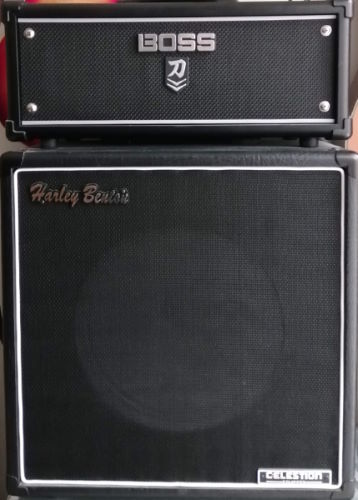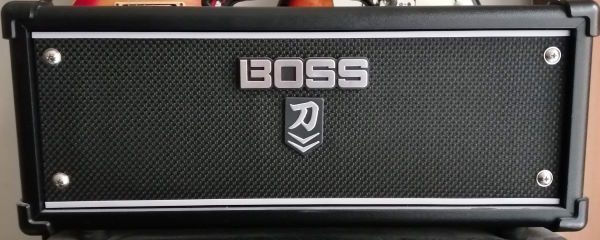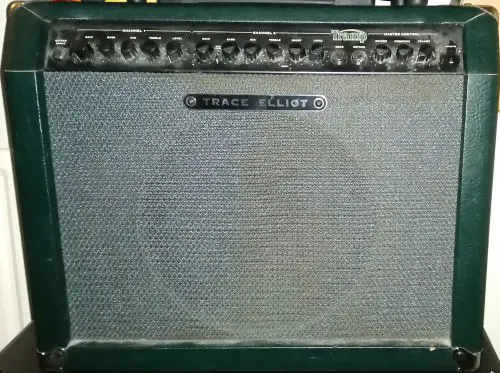When I first started getting interested in playing electric guitar in the late 1980s, I didn’t even realize that you needed an amplifier to be able to hear the sound. Eventually, I learned there were two different physical forms of guitar amplifier – separate heads and cabs, and combos.
A guitar amp head is a guitar amplifier without a built-in speaker. It requires connecting to a separate speaker cabinet or “cab” for the sound to be heard. This contrasts with combo amps or “combos”, where the amplifier and speaker are enclosed together in one physical unit.

The “combo” vs “separate head & cab” debate is one that has raged throughout the decades between electric guitar players. Each has its advantages and its drawbacks, and which one you go for depends on what you want to use it for and where you want to use it.
You may be surprised to learn that you don’t necessarily need to play your electric guitar through an amp at all! Check out my “How to play electric guitar without an amp” article to learn all about the different ways to play amp-less.
If you are interested in checking out the best recording gear such as audio interfaces, studio monitor speakers, microphones, etc., you can find them at Amazon by clicking here.
What Is A Guitar Amp Head?
There are two basic parts to a guitar amplifier; an amplifier part and a speaker part. The amplifier part contains the electronics to actually amplify the signal coming from your electric guitar. The speaker part then turns that amplified electrical signal into actual sound – vibrations through the air that you hear as sound when those vibrations hit your ears.
A guitar amp head is just the amplifier part. It has no speaker built into it. If you play your electric guitar through a guitar amp head without a separate speaker connected, then you will hear no sound.

Normally there is no speaker in the guitar amp head. If you buy a head, you need to buy a speaker cabinet or cab. You would then connect the speaker output of the head into the input of the cab using a speaker cable. This is a jack cable similar to a guitar cable, but rated for the higher current that will travel from the head to the speaker.
Never use a regular guitar cable to connect a guitar amp head to a cab!
What is a “combo”?
A combo or “combination amplifier” is a guitar amp where the amplifier and speaker parts are both housed together in one housing i.e. the speaker is built-in. You do not need to buy a separate speaker cabinet for a combo. If you plug your guitar into a combo amp, you will be able to hear your guitar just fine without a separate cab. So if you buy a combo, that’s the only thing you need.

What is a “cab”?
A guitar speaker cabinet or “cab” is a unit that contains one or more speakers. It contains no electronics of its own, just the speakers. It will have an input jack connection, which you would connect the speaker output from a guitar amp head to.
You would need a separate speaker cab to be able to hear the sound from a guitar amp head. You do not need one to hear the sound from a combo, as in a combo the speaker is built-in.
Having said that, there are certain setups and situations where you can play through just an amp head without using a cabinet. Check out my “Can you play through just an amp head?” article for details on when you can use a head on its own.
What is a “stack”?
A “stack” is a term that simply refers to the combination of an amp head and a speaker cabinet. It is very common to place the head on top of the cab, hence the term “stack“.
You will sometimes hear the term “half-stack” as well. This refers to a head on top of one speaker cabinet, whereas strictly speaking a “stack” or “full-stack” refers to a head on top of two speaker cabs placed on top of one another.
With the technology available these days, it’s not always necessary to use a guitar amp to play your electric guitar through. Software guitar amp simulators (“amp sims”) can be used to effectively turn your computer into a guitar amp. Check out my guide on using your PC as a guitar amp for full details and instructions.
Separate head & cab vs combo – advantage and disadvantages
Combo amps offer the benefit that they are easy to set up in that they are just one unit. There is no separate speaker cab to connect and setup; you simply plug in your guitar, turn on the amp and play! For that reason, beginners’ first amps tend to be combos.
A combo will also generally be cheaper than buying the equivalent separate head and cab. Although take into account that if in the future you want to upgrade your amp, if you have a combo then you will have to buy a whole new combo unit. On the other hand if you have a head and cab, you need only buy a new head and run it through your existing cab that you already own.
That last point leads us on to an advantage of the head/cab setup – its versatility. With a combo you are stuck using the built in speaker, whereas you can try your head with a variety of different cabs until you find one that it works well with.
You could actually change the speaker in your combo if you know what you’re doing with a soldering iron. Or you could add an extension cabinet to some combos. But if you’re asking the question “what is a guitar amp head” it’s unlikely you’re at this stage in your guitar playing career yet!
If you are thinking of buying your first amp, do you need just a practice amp? If you don’t do any gigging yet, this should be all you need for now. If so, the vast majority of practice amps are in the combo format.
In practice it doesn’t really matter which format you choose – you can get a great sound from either setup. If someone tries to start the head/cab vs combo argument with you, my advice is to nod politely then start slowly moving towards the nearest exit 😉
As a quick aside…obviously, you are familiar with using a guitar amp with a guitar. But did you know you can also run vocal microphones through a guitar amp?! It may sound crazy, but it’s actually an unorthodox way of getting a cool, unusual vocal sound, or saving some money on vocal amplification. Check out my article on running vocals through a guitar amp to learn how to safely do this, and some common mistakes to avoid.
Do tube amps only come in “head” form?
No. You can buy both tube heads and tube combos. The same is true for other types of amps – solid state and digital modelling amps also come in both head and combo formats.
I think that this misconception comes from the fact that many professional guitar players play tube amps. They are also the most likely to play through separate heads and cabs, so it’s easy to see how this mistaken correlation could be made.
You can buy all the different types of amp in both head and combo form.
Which is best for a home studio – combo or head/cab?
This is very much dependent on your home studio.
How much room do you have? How loud can you play? Do you need lots of amps that you can swap in and out using the same cab? Do you need to move your amp around? Will you also gig with your amp – will you be moving it in and out of your studio?
Ask yourself these questions, and you should come up with the answer that is appropriate for you in your particular situation.
If you have a home studio, you could well want to connect your guitar amp to your computer for recording or other applications. I have an article that shows you exactly how to connect your guitar amp to your computer, detailing several different methods.
Can you use a separate cab with a combo amp?
You can often use a separate cab with a combo amp. If your combo has a separate speaker output, you should be able to connect what’s called an “extension cab” to it.
Why would you want to do this? Well, adding more speakers to your combo will change the sound. It will make it louder, and typically give it more bass and kick out a fuller sound. This may be what you want for playing gigs with your band, or you may just like the fuller sound that adding an extension cab provides.
Do separate amp & heads sound better than combos?
No. You can get a great sound from either format.
Separate heads and cabs are more versatile in this regard. You can get many more sounds from a head than you could from a combo simply by connecting it to lots of different speaker cabinets. Whereas with the combo, you are stuck with the built-in speaker.
It is sometimes misunderstood how much the speaker cabinet contributes to the tonal quality of your guitar sound. The same head connected to a different speaker cabinet can produce a very different sound. It is sometimes believed that all the tone comes from the amp, and the speaker is just there so you can hear your guitar. This is not the case! The speaker and cab play a huge part in the overall tone.
So if you are shopping for a head, it is always worth trying it with several different cabinets to find one that sounds really good with it. Just because a cabinet sounds good with one head, doesn’t mean it will necessarily sound good with a different head.
Thanks for reading this article. One last thing; if you are recording electric guitars via guitar amps or other means, it’s often desirable to get those guitars sounding as big and full in the mix as possible. I have a guide on making your guitars sound big in the mix, which gives you tips on achieving that full sound without overpowering the other instruments.
Here is some of my favorite home studio gear…
Thanks for reading this article. I hope you found it helpful in your home music-making activities. Here are a few of the tools that I personally use in my home studio. These are affiliate links, so if you decide to use any of them I’ll earn a small commission.
Audio interface: My personal choice for audio interfaces are the Focusrite Scarlett series. I have been using these for years, and they have always given me great-sounding recordings. For a very reasonable price from Amazon you can buy the excellent Focusrite Scarlett 4i4, or if you don’t need MIDI capability the Focusrite Solo is a great choice.
Amp sim: Guitar amplifier simulator software has come on leaps and bounds in recent years, such that I record all my electric guitar parts using amp sims these days. One of the very best is the incredible Amplitube from IK Multimedia, which I have used on many of my songs.
Headphones for recording: My favorite headphones for recording are the Sony MDR-7506s, which I use for monitoring during all my recording sessions. They can also be found in many pro recording studios. Get the Sony MDR-7506 headphones from Amazon here.
General-purpose microphone: You can’t go wrong with a good ol’ Shure SM-57, one of the most versatile and ubiquitous microphones around. I’ve been using one in my home studio for as long as I can remember. Amazon offers the Shure SM-57 for a very competitive price.
To see all of my most up-to-date recommendations, check out this resource I made for you!


